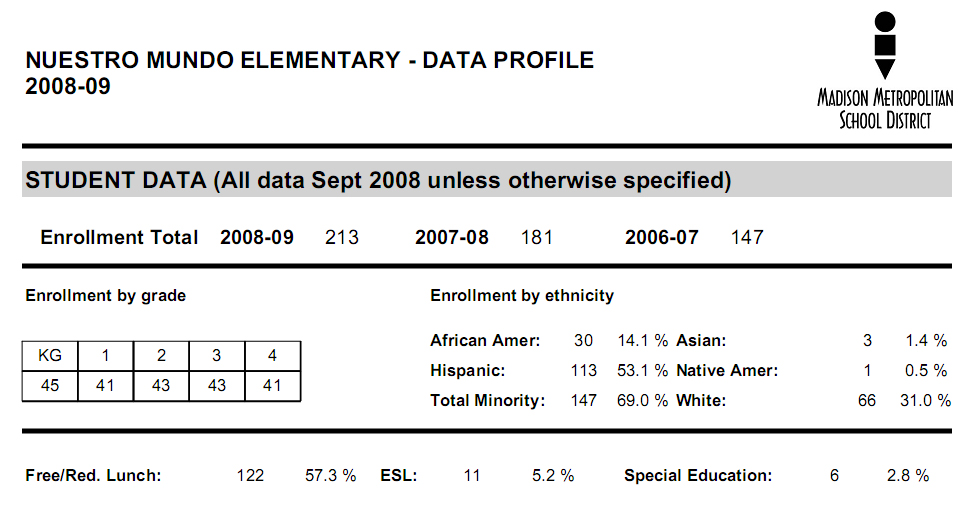This is the post I meant to write when I wrote about my little boy growing up. Now that I’ve had a moment to sigh and reflect and then to record all the dates for the 2010-11 school year in my calendar, I’m feeling a little more onboard with the whole “going to kindergarten” thing.
Our elementary school is just around the corner from our house. I love the idea of walking to school. I sure have loved walking (or biking or sledding) Andrew to Monona Grove Nursery School, which is just across the street from his elementary school. It feels so neighborly and sweet to be right close by.

The Frank Allis school houses (in apparently very crowded conditions) two separate schools. The first is the normal Allis Elementary School. There’s a nice little write-up about that school on their website. Looks like it’s been a school for 92 years! The second is a dual language charter school called Nuestro Mundo (click here for more info on their program).
On Monday night, I hurried through the falling light to attend an informational session on Nuestro Mundo. As I crossed the street toward the school, I stopped for a moment to snap the photo above on my phone. I’ve never been in this school before, and it struck me that after I walked through the doors, it would never be “new” again. At some point, it will probably be so homey and familiar that I won’t even remember what it felt like when this building was new and foreign and a little bit scary.
The informational session was held in a third grade classroom, and the room was packed. It seemed to be about half English speakers and half Spanish speakers. The teacher who led the session addressed the room in Spanish and was then translated by another teacher. Questions were answered in both languages. Apparently, for future meetings (and PTO meetings and things like that) the presentations are done in Spanish, and English speakers wear a headset where they can hear simultaneous translations so the meetings go a little faster.
Nuestro Mundo is a charter school, and they enroll about 50% Spanish speaking kids and 50% English speaking kids. (See here for an article written about the school by my friend Samara.) In kindergarten, the instruction is 90% in Spanish, and it shifts about 10% a year until by third grade, instruction is half English, half Spanish. Children are taught literacy first in Spanish and then, after they are proficient readers, in English.
There is a lottery for enrollment in the school, and it sounds like about half of the students who want to get in actually make it. So in a way, I don’t want to get too caught up in wanting this program, because who knows if we’ll get in.
Here are some of my thoughts as I approach the idea of picking the right school for Andrew:
- I want Andrew to love school. I’d like him to be happy at school, to connect to his teacher, to smile with his classmates, to feel comfortable and confident and secure. I’d like him to skip on his way to school. And even if he never will tell me one little bit about his day, I’d like to know in my heart that it was a good one, full of nice friends, compassionate teachers, and fun activities.
- Wherever her goes, I wouldn’t be surprised if it takes my young boy a little while to warm up. Andrew seems to be an observer by nature. I notice that in group settings, he often waits on the sidelines and checks things out until he feels comfortable enough to jump in. That said, he has a great time in his own little sidelines, and he’s usually very content to play games or read or do art on his own until he’s ready to engage with others. At least in preschool, Andrew seems to be a kid who plays well with everyone but who doesn’t have a couple special friends. Whenever I ask him about his friends, he’ll rattle off the names of several kids, and if I try to suss out who he most enjoys spending time with, he smiles and throws up his hands, “I like all my friends at school, Mom!”
- Academically, I think that Andrew is pretty advanced right now. Due to his focused, cognitive nature, he’s been fascinated with letters and reading for the last year. If he’s in the mood, he can now read almost any picture book he picks up. I love it when he reads to Sylvia! His writing is somewhat legible, and he really enjoys writing “journals” and books. At the suggestion of his preschool teacher, I’ve made a little dictionary for him with all the words that he’s asked me to spell for him. It’s one of his favorite possessions. Andrew is also really interested in numbers and math, and he often asks me to quiz him with “a tricky one” about addition or subtraction. He loves telling the temperature, and we’ve been having fun this winter with negative numbers:)
Because of all this, I think that the academic content of a traditional kindergarten will be much less important than the social and enrichment aspects of going to school. In the dual immersion language program, it looks like kids score lower on academic achievement testing for several years (actually until 6th grade at which point they score better than traditional classrooms). I’m guessing that this is because the kids are working on language skills in addition to everything else. If Andrew goes to the dual immersion language program, his early literacy and math skills might not lag as much as they do for kids since he’s starting out with many early skills, and that makes me feel a little better, because to tell the truth, I have a bit of a hard time signing up for a program that could from some perspectives leave Andrew at an academic disadvantage.
- The things that I love, love, love about Nuestro Mundo is that it could give Andrew something that Bryan and I can’t give him…fluency in a second language. Even more than that, though, the school is designed to help students become global citizens. I love the idea of Andrew gaining a multicultural education (actually, this is true in either school). I love the idea of a school where he learns at such an early age about how to dive in and learn a new language, a new culture.
Before I had kids, I remember thinking that I really wanted to expose them to a wide variety of people and cultures and situations. I had hoped to spend time in parts of town or in parts of the world that are very different from ours so that we could, together, build familiarity with that which initially feels foreign. We haven’t really done this at all, and so maybe this is a great way to start!
- A couple weeks ago, I read an article in my alumni magazine, The Carleton Voice about Carleton’s growing international program. I thought the lesson applied strongly to our kindergarten choice:
About three years ago, stormy weather stranded Carleton President Robert Oden Jr. in the Detroit airport. Although his 37-hour delay was both regrettable and forgettable, he came across a magazine article that wasn’t. On the subject of global leadership, the writer had interviewed more than 20 leaders in business, industry, the arts, and government from around the world.
“When they were asked how future leaders should be educated, their answers were remarkably similar,” recalls President Oden. “Almost all of them said something like: ‘Become fluent in at least two, preferably three languages—and spend as much time as you possibly can with people from other countries.’ ” A number of the leaders went on to describe the importance of developing the knowledge, understanding, and skills required to effectively communicate and negotiate with people from anywhere in the world.”
Fine! I thought, I’ll be brave! I’ll sign Andrew up for a program in which he’ll be jumping into 90% Spanish. The teachers seem terrific, and they’ll help him along. Andrew seems to talk in gibberish half the time, and he eats up the Spanish words that I share with him, so picking up a new language should come pretty easy to him.
Ahh, I don’t know. I find myself really leaning toward Nuestro Mundo, but I’m wondering…what are your thoughts?
FYI, here’s the school data profile for the Frank Allis Elementary School and here’s the school data profile on Nuestro Mundo.





































